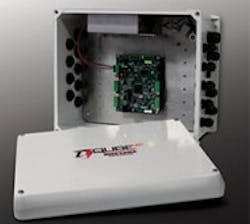Load Cell Junction Box Smartens Up
Any multiple load cell system requires a summing junction box to sum and trim the load cell outputs.
To achieve the speed necessary for many applications, a system integrator traditionally had to use a single-channel analog-to-digital converter (ADC) and an analog summing box. In doing so, the ability to diagnose individual load cell performance was lost. Some digital summing boxes offer beneficial cell diagnostic data, but as the number of modules in a platform increase, a system will lose speed. This also locks the process into a proprietary protocol and display.
Rice Lake Weighing Systems says it has a better idea with the release of iQube2, which can update up to 200 times per second on multi-channels. A digital junction box should do much more than just sum and trim, they say. “Our junction box can simultaneously monitor load cell function and provide incredible speed,” claims Tony Boehm, senior electrical engineer at Rice Lake. “What’s more, advanced diagnostic features alert the user the instant a problem is detected, while the system can compensate for that failure immediately to keep the scale operational.”
For more information
Call 800/472-6703, email [email protected] or browse to www.ricelake.com/exclusive.
Boehm says a theoretical calibration option uses each load cell’s physical characteristics to calibrate the scale with a single command. Additional trimming and calibration options include Sectionmatch for trimming based on paired cells, Cornermatch for individual cell trimming and Scale Span for when trimming isn’t required.
“If a load cell is damaged, the system can emulate that cell’s output based on the output of its neighboring cells,” adds Boehm. “A damaged board can be replaced simply by uploading its parameters to the replacement, and the scale typically will retain its calibration to 0.02% of full scale output.”
Every iQube2 circuit board is designed with four high-speed, 24-bit Sigma-Delta ADC converters, but the daisy-chainable system can be expanded to four boards and accommodate 16 load cells. Boehm says ADC channel sample rates range 2.5–500 Hz with noise performance ~3 nV at 15 Hz and 17 nV at 500 Hz.
Each ADC channel has cell level diagnostics that check for cell connection faults, under- and over-loaded cells and excessive noise. The health of each load cell, adds Boehm, is indicated by a bi-colored LED, but also can be communicated serially and/or configured for remote monitoring using the four I/O channels. Additionally, each circuit board continuously monitors the input power supply voltage and excitation voltage. Scale specific diagnostics check for cell linearity, failure of a scale deck to return to zero and cell drift under load.
When configured as an input, the digital I/O can perform common scale tasks such as tare, zero and units. As an active low output, an I/O channel can sink 25 mA and can be controlled via host commands or assigned to a scale as a free-running setpoint, like trip higher, lower or in-band.
“iQube2 was designed with an ASCII-text-command-based open protocol allowing any HMI to retrieve usable weight data,” says Boehm. “Six data formats can be customized for serially streaming to, or polling, nearly any process controller format.”
The serial communication port is isolated to prevent ground loops and uses a multi-protocol system that accommodates RS-232 and RS-422/485 (full or half-duplex). Available connectivity card options include fiberoptic, Ethernet, wireless Ethernet, USB and multi-protocol RS-232/422/485.


